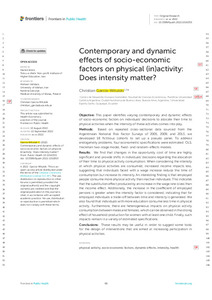Por favor, use este identificador para citar o enlazar este ítem:
https://repositorio.uca.edu.ar/handle/123456789/15244| Título: | Contemporary and dynamic effects of socio-economic factors on physical (in)activity: Does intensity matter? | Autor: | García Witulski, Christian Martín | Palabras clave: | ACTIVIDAD FISICA; FACTORES SOCIOECONOMICOS; INACTIVIDAD FISICA; TRABAJADORES; ESTADISTICAS | Fecha de publicación: | 2022 | Editorial: | Frontiers Media | Cita: | García Witulski, C. M. Contemporary and dynamic effects of socio-economic factors on physical (in)activity: Does intensity matter? [en línea]. Postprint de articulo publicado en: Frontiers in behavioral neuroscience. 2022, 10, 1016353. doi: https://doi.org/10.3389/fpubh.2022.1016353. Disponible en: https://repositorio.uca.edu.ar/handle/123456789/15244 | Proyecto: | Valuación de la mortalidad, años y esperanza de vida perdidos atribuibles a enfermedades no transmisibles debidas a la insuficiente actividad física en Argentina | Resumen: | Objective: This paper identifies varying contemporary and dynamic eects of socio-economic factors on individuals’ decisions to allocate their time to physical activities when the intensity of these activities comes into play. Methods: Based on repeated cross-sectional data sourced from the Argentinean National Risk Factor Surveys of 2005, 2009, and 2013, we developed 18 fictitious cohorts to set up a pseudo panel. To address endogeneity problems, four econometric specifications were estimated: OLS, Heckman two-stage model, fixed- and random-eects models. Results: We find that changes in the opportunity cost of time are highly significant and provide shifts in individuals’ decisions regarding the allocation of their time to physical activity consumption. When considering the intensity at which physical activities are consumed, increased income impacts less, suggesting that individuals faced with a wage increase reduce the time of consumption but increase its intensity. An interesting finding is that employed people consume more physical activity than inactive individuals. This indicates that the substitution eect produced by an increase in the wage rate is less than the income eect. Additionally, the increase in the coe cient of employed persons is greater when the intensity factor is considered, indicating that for employed individuals a trade-o between time and intensity is generated. We also found that individuals with more education consume less time in physical activity. Furthermore, there are heterogeneous impacts on physical activity consumption between males and females, which can be observed in the strong eect of household production for women with at least one child. Finally, such impacts remain in a variety of estimated specifications. Conclusions: These results may be useful in order to suggest some tools for the design of interventions that are aimed at increasing participation in physical activities... | URI: | https://repositorio.uca.edu.ar/handle/123456789/15244 | ISSN: | 1662-5153 (online) | Disciplina: | SOCIOLOGIA | DOI: | 10.3389/fpubh.2022.1016353 | Derechos: | Acceso abierto | Fuente: | Frontiers in behavioral neuroscience 10,1016353. 2022 |
| Aparece en las colecciones: | Artículos |
Ficheros en este ítem:
| Fichero | Descripción | Tamaño | Formato | |
|---|---|---|---|---|
| contemporary-dynamic-effects.pdf | 448,59 kB | Adobe PDF |  Visualizar/Abrir |
Visualizaciones de página(s)
83
comprobado en 27-abr-2024
Descarga(s)
50
comprobado en 27-abr-2024
Google ScholarTM
Ver en Google Scholar
Altmetric
Altmetric
Este ítem está sujeto a una Licencia Creative Commons

